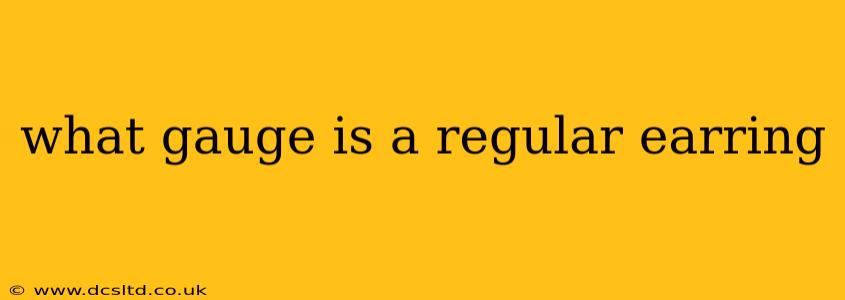What Gauge is a Regular Earring? Understanding Earring Gauge
The question "What gauge is a regular earring?" doesn't have a single, simple answer. The "regular" gauge for earrings depends heavily on several factors, including personal preference, piercing location, and the style of earring. There's no universally accepted "standard" gauge. However, we can explore the common gauges and what they mean.
What is Earring Gauge?
Before we dive into common gauges, let's understand what gauge actually means. Earring gauge refers to the thickness of the earring post, measured in gauge numbers. Unlike most measurements, the gauge system is inverse: a lower gauge number indicates a thicker post, while a higher gauge number indicates a thinner post. This can be confusing at first!
For example, a 20-gauge earring is thinner than an 18-gauge earring.
What are the Most Common Earring Gauges?
While many gauges exist, these are some of the most frequently used for pierced ears:
-
20 Gauge (0.81 mm): This is often considered the standard gauge for initial ear piercings, particularly for lobe piercings. It's a relatively thin gauge, making it comfortable for healing and generally suitable for lighter earrings.
-
18 Gauge (1.02 mm): Slightly thicker than 20 gauge, 18 gauge is also quite common for both initial piercings and those that have healed. It can handle a wider variety of earrings than 20 gauge.
-
16 Gauge (1.27 mm): This thicker gauge is frequently chosen for heavier earrings or for those who want more substantial-looking jewelry. It's generally less common for initial piercings.
What Gauge is Best for My Ear Piercing?
The best gauge for your ear piercing depends on:
-
Your piercing's location: Cartilage piercings, like helix or tragus piercings, often start with a thicker gauge (like 16 or even 14 gauge) for structural support and healing. Lobe piercings typically use thinner gauges.
-
Your personal preference: Some people prefer the look and feel of thinner earrings, while others prefer thicker ones.
-
The type of earring: Heavier earrings usually require a thicker gauge to prevent stretching or tearing.
What Gauge Are My Existing Earrings?
If you're unsure of the gauge of your existing earrings, it's difficult to determine this without a gauge tool. Jewellers often have tools for measuring gauge, or you can search online for comparison charts that offer visual representations of various gauges.
Can I Change the Gauge of My Ear Piercing?
Changing the gauge of your existing piercing should only be done by a professional piercer. They have the tools and expertise to do so safely, preventing complications and infection. Attempting to do this yourself can lead to serious damage and infection.
What gauge is best for a second piercing?
The gauge for a second piercing depends on the same factors as the initial piercing: location and personal preference. Many people opt for the same gauge as their initial piercing, while others might choose a slightly different gauge depending on the type of jewellery they want to wear. Always consult a professional piercer for advice.
This comprehensive guide should offer a clear understanding of earring gauges and help you make informed decisions about your own piercings. Remember to always consult with a reputable piercer for personalized advice and safe piercing practices.
